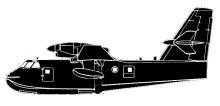Incident Overview

Description
An accidental fire started around 14:30 on a hillside near Seravezza, Italy. A helicopter was called in the extinguish the fire. Since the fire spread rapidly, a second helicopter was ordered, but there were no helicopters available. The Department of Civil Protection was contacted to send a fire fighting airplane. A Canadair CL-415 departed Roma-Ciampino Airport (CIA) at 16:28 on a fire fighting mission. It arrived at the scene of the fire at 17:20. After a survey of the scene the crew commenced their mission. At 18:04, immediately after releasing the water, the airplane contacted the cable guard of a power line. The right hand float separated from the wing and a fire erupted on the severed wing. The pilots lost control and the airplane came down in a residential area, crashing into an unoccupied house. PROBABLE CAUSES AND CAUSAL FACTORS (translated from Italian) The accident was triggered by the collision of the aircraft against the cable guard of a power line during a fire fighting mission. The collision was caused by an inadequate trajectory towards the front of the fire. The damage suffered as a result of the impact against the power line seriously compromised the controllability of the aircraft, affecting a positive outcome of the emergency. The following causal factors may have contributed to the dynamics of the accident: – Poor decision making in attacking the fire, causing the crew to focus their attention on obstacles (pylons) of Power Line No 500, without considering the presence of the cable guard line n.550; – The reduced visibility of obstacles resulting from the smoke of the forest; – The inadequate reporting of electricity pylons and associated overhead lines; – Non-activation of the required radio links, so the crew could not receive reports on the presence of obstacles; – Short and discontinuous experience of the captain in that role, coming from the institution of the “PIC Frozen”; – The combination of to similar qualified pilots (“PIC Frozen”) in the cockpit for the operation of a flight, one just rehabilitated to a high command function, the other still employed in the role of co-pilot: This condition could have a negative impact in terms of crew integration, obscuring decision making; – The existence of criticality in corporate manuals used at the date of the accident; – Reduced operational capacity of the crew in the last phase of flight, resulting from the strong heat of the fire under the left wing which penetrated the airplane through an opening created by the separation of a porthole.
Primary Cause
Collision with a power line cable guard during a fire-fighting mission.Collision with a power line cable guard during a fire-fighting mission.Share on:




